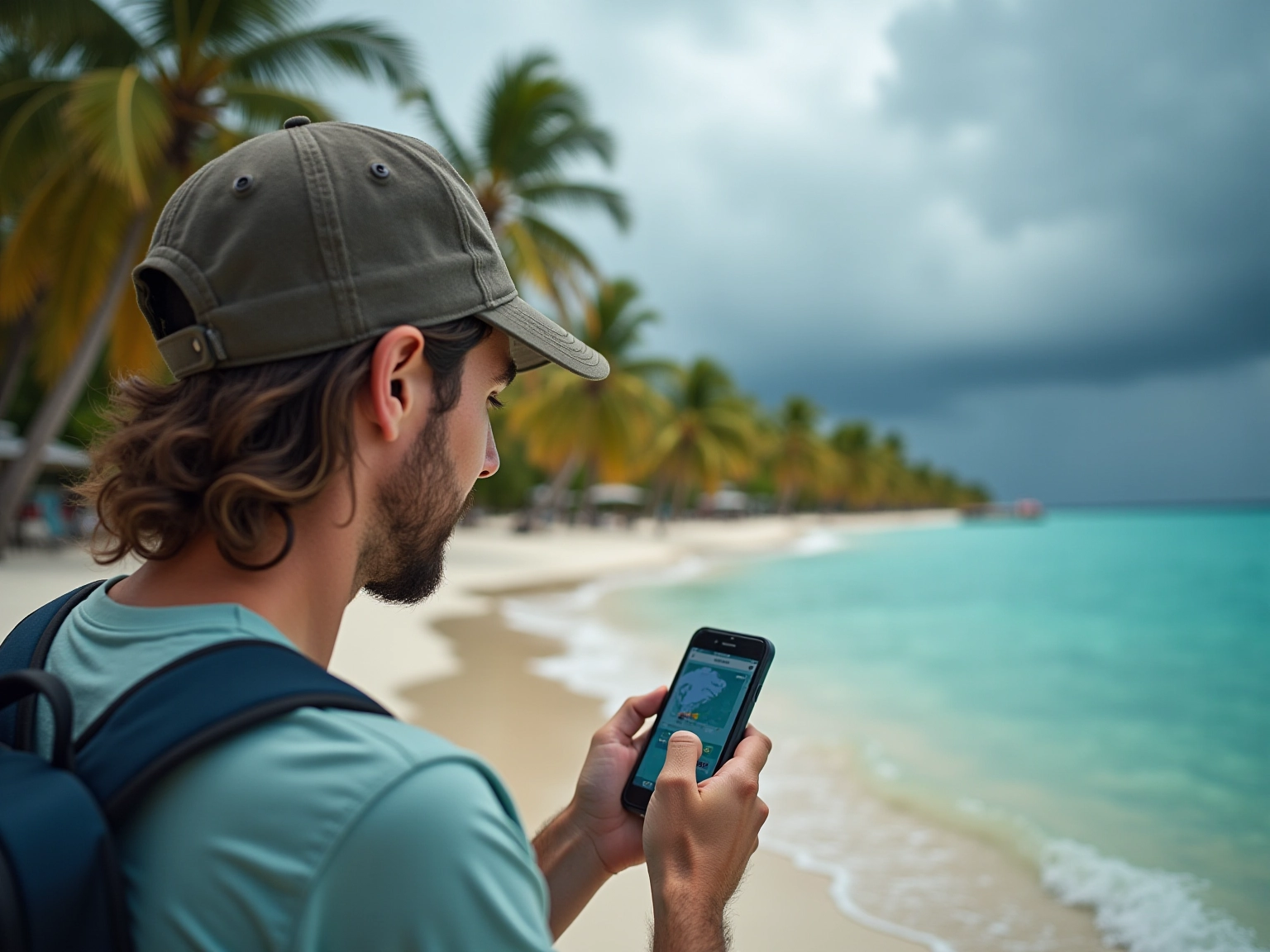Overview
Aruba is a fantastic choice for your travels, especially during hurricane season! Thanks to its unique geographical position, this beautiful island significantly reduces the risk of direct storm impacts, making it a relatively safe destination. You’ll find that Aruba’s historical resilience to storms is quite impressive, and the low average annual storm risk is just one of the many reasons to consider visiting.
Plus, traveling during this time comes with some added perks! You can enjoy lower travel costs and experience fewer crowds, allowing you to explore the island more freely. So, why not plan your trip to Aruba while keeping an eye on potential weather developments? It’s all about making informed decisions while you embark on your exciting adventure!
Key Highlights:
- The Caribbean hurricane season runs from June 1 to November 30, but Aruba’s geographical position significantly reduces its risk of direct storm impacts.
- Historically, Aruba has experienced very few tropical storms, with the last notable event being Storm Felix in 2007.
- Aruba is considered one of the safer Caribbean destinations during hurricane season, with a low average annual storm risk.
- Travelers can benefit from lower transportation costs and fewer crowds during hurricane season, making it a budget-friendly time to visit.
- Essential precautions include monitoring weather forecasts, obtaining travel insurance, and having an emergency plan in place.
- The 2025 hurricane season is predicted to see 13 to 18 named storms, highlighting the need for travelers to stay informed.
- Engaging in local cultural activities and exploring indoor attractions can enhance the travel experience during potential rainy days.
- Travelers are encouraged to remain flexible with their plans and to familiarize themselves with emergency contacts and procedures.
Introduction
In the heart of the Caribbean, Aruba shines as a beacon of safety and charm, especially during the hurricane season that stretches from June to November. You might be wondering whether it’s a good idea to visit during this time. Well, let me assure you, Aruba’s unique geographical position offers a comforting buffer against the brunt of storm activity, making it one of the safest destinations in the region! With a history marked by minimal hurricane impacts, you can explore the island’s stunning landscapes and rich cultural experiences with peace of mind.
This article dives into the dynamics of hurricane season in Aruba, providing essential insights for you as a traveler looking to navigate your plans confidently while enjoying the myriad benefits of off-peak travel. From understanding historical weather patterns to practical tips for maximizing your enjoyment, Aruba’s hurricane season presents an opportunity for adventure and exploration like no other. So, are you ready to discover what Aruba has to offer during this unique time?
Understanding Hurricane Season in Aruba: Timing and Impact
The storm season in the Caribbean officially runs from June 1 to November 30, coinciding with what we call Aruba and hurricane season. But here’s the good news: Aruba’s unique geographical position, nestled south of the storm belt, significantly lowers its risk of direct storm impacts. Historically, the island has been quite lucky, with very few tropical storms making their way here. The last notable event was Storm Felix in 2007, which thankfully passed to the north of the island.
This historical context is super important for you as a traveler! While we recognize Aruba and hurricane season, it’s reassuring to know that the island consistently ranks as one of the safer Caribbean destinations during this time.
Meteorologists point out that Aruba’s location offers a protective shield against the more intense effects of tropical storms. For instance, the island’s average annual storm risk is impressively low, with only a handful of events impacting it directly over the past several decades. This is a stark contrast to other Caribbean islands that face more frequent and severe storm threats.
In fact, did you know that recent statistics show 90% of homes on Union Island were devastated during a storm? This really highlights the resilience that Aruba maintains in comparison.
As you plan your travels, it’s also wise to think about the broader effects of hurricanes during Aruba and hurricane season. Although the chance of a direct strike is slim, this time of year can still influence movement patterns and availability. Many tourists choose to explore the island during this period, drawn in by its relatively consistent climate and the opportunity for reduced travel expenses.
Plus, Aruba’s tourism infrastructure is well-prepared for this season, ensuring you can enjoy your stay with peace of mind.
Understanding the dynamics of tropical storms in the region not only eases your worries but also emphasizes the island’s resilience and readiness. As Simon Stiell, U.N. Climate Change Executive Secretary, noted, “Whether in my homeland of Carriacou … hammered by Hurricane Beryl, or in the heatwaves and floods crippling communities in some of the world’s largest economies, it’s clear that the climate crisis is pushing disasters to record-breaking new levels of destruction.”
This really underscores the importance of being aware of storm risks in the Caribbean.
With its rich cultural experiences and stunning landscapes, Aruba continues to be an appealing destination for travelers like you, looking for both adventure and security during Aruba and hurricane season. Recent events, like Hurricane Elsa, which occurred from June 30 to July 10, 2021, and passed 252 km northeast of Aruba, further illustrate the island’s fortunate positioning. By understanding the historical storm data and the proactive measures in place, you can confidently plan your visit to this beautiful destination.
Forecasting the Future: What to Expect in the 2025 Hurricane Season
Get ready, fellow adventurers! The 2025 storm season is shaping up to be quite the event, with predictions suggesting we could see between 13 to 18 named storms, including 7 to 10 cyclones and 3 to 5 significant storms rated Level 3 or higher. This insight comes from the experts at Colorado State University, and it indicates a notable uptick in storm activity compared to recent years. While Aruba often escapes the brunt of these storms, it’s wise for travelers like you to stay alert and keep an eye on weather updates as your travel dates approach, especially during the peak hurricane months of August and September.
Now, here’s something to consider: there’s a 51% chance of a major tropical storm making landfall along the U.S. coastline this year! This highlights the importance of being prepared for storm activity in the Caribbean, especially if you’re planning a visit. And did you know there’s also a 10% chance of a major storm coming within 50 miles of Alabama? That’s according to CSU experts, who remind us of the broader risks linked to storm forecasts. Plus, a recent case study titled ‘Storm Risk in Alabama’ reveals a 67% chance of a storm and a 34% chance of a cyclone impacting Alabama this year. It’s a great reminder for all travelers to stay ready!
Let’s not forget recent history! Three storms—Debby, Helene, and Milton—made landfall in Florida during the 2024 season. These factors really underscore the need for vigilance and preparedness for anyone heading to the Caribbean. So, as you plan your adventures, keep this in mind and stay safe out there!
Traveling to Aruba During Hurricane Season: Key Considerations
Journeying to Aruba during hurricane season? Let’s talk about how to prepare for a seamless experience! While the chances of hurricanes directly hitting Aruba are relatively low, it’s smart to stay alert about potential flight delays or cancellations due to storms affecting nearby islands. To keep your plans flexible, consider booking arrangements that allow for changes without those pesky fees.
And don’t forget about travel insurance! It’s a must-have, especially one that covers weather-related disruptions. This little safety net can give you peace of mind if your travel plans unexpectedly shift. Staying in the loop with local weather updates is key; make it a habit to check forecasts and keep an eye out for any advisories from local authorities.
In case of emergencies, having essential contact information handy is crucial:
- police (100)
- ambulance (911)
- firefighters (911)
- coastguard (913)
It’s also a good idea to have a contingency plan. Familiarizing yourself with the locations of emergency shelters and local emergency contacts can be invaluable if severe weather strikes.
Engaging with local tourism boards can enhance your safety, too! They often provide the latest information on safety protocols and resources available during Aruba’s hurricane season.
As one traveler shared, “You should be good to go with the destination in July.” Aruba is a wonderful place, full of friendly people, even if it’s currently at the center of a sad story. So go ahead, enjoy your time there! Bon Bini! This sentiment perfectly captures the island’s inviting character, which is also highlighted in the case study titled “The Island as a Spring Break Destination,” showcasing its charm as a family-friendly getaway.
By taking these proactive steps, you can soak in the beauty of the island while minimizing the impact of any potential weather disruptions.
The Upside of Off-Peak Travel: Benefits of Visiting Aruba in Hurricane Season
Visiting Aruba during hurricane season is a unique opportunity for savvy explorers like you to enjoy some fantastic benefits, especially through the fresh perspective that Karen LeBlanc champions. One of the most enticing perks is the significant drop in transportation costs. Many resorts and airlines roll out attractive discounts to draw visitors during this off-peak time, making it the perfect moment for budget-conscious travelers to discover the island.
For instance, accommodations can be up to 30% cheaper than during peak times, allowing you to stretch your budget even further! Plus, the island experiences fewer crowds during storm periods, which means that popular attractions and stunning beaches are much more accessible. This creates a peaceful atmosphere for relaxation and exploration.
You can savor a more personal experience at famous spots, often without the long waits or bustling crowds typical of peak tourist seasons. However, it’s crucial to keep in mind the risks associated with visiting Aruba during hurricane season. For example, Tropical Storm Gamma caused significant disruptions, resulting in 39 fatalities, including 34 in Honduras, underscoring the potential dangers of traveling at this time.
Similarly, Hurricane Dennis brought about severe flooding and landslides in Haiti, highlighting the importance of staying informed about weather conditions while you’re in Aruba.
On the bright side, hurricane periods often coincide with unique local events and festivals, giving you the chance to immerse yourself in Aruba’s vibrant culture. These events frequently showcase local artistry, music, and culinary delights, enriching your experience with authentic cultural interactions. As travel specialists note, off-peak times can provide distinctive opportunities to connect with local communities in ways that peak seasons simply don’t, perfectly aligning with the insights of The Design Tourist.
That said, it’s wise to be prepared for the challenges that may arise, such as those faced by kitesurfers at Fisherman’s Hut, where turbulent winds and crowded conditions can lead to frustrating experiences. This example illustrates the importance of being ready for the unique circumstances that storm periods can create.
Overall, the combination of lower costs, fewer crowds, and the chance to dive into local culture makes visiting Aruba during hurricane season an appealing option for those looking to enrich their experiences while enjoying significant savings—just stay aware of the possible challenges!
Staying Safe: Essential Precautions for Travelers in Aruba
Traveling to Aruba during hurricane season? It’s all about careful planning and keeping safety in mind to ensure you have a secure and enjoyable experience! First things first, you’ll want to keep a close eye on the weather forecasts. Staying updated on any developing storms allows you to make quick changes to your travel plans when necessary.
I highly recommend getting insurance for your trip that specifically covers cancellations due to weather-related incidents. Options like Cancel for Any Reason (CFAR) coverage can provide peace of mind, especially when the weather can be so unpredictable. Just think about the case study on insurance during hurricane season—it really highlights the importance of being prepared!
Having a solid emergency plan is also crucial. Familiarize yourself with nearby shelters and keep a list of emergency contact numbers handy. Trust me, this preparation can be invaluable if a storm hits while you’re in Aruba.
And let’s talk about flexibility! Being open to rearranging your activities based on the weather can really enhance both your safety and enjoyment.
With the potential for extreme weather during hurricane season, understanding the value of trip insurance is key. Did you know that weather-related cancellations can lead to significant financial losses? That’s why investing in insurance is a smart move for travelers. It’s also a good idea to seek expert advice about insurance options to ensure you’re well-informed about your choices.
Lastly, knowing how to use contraflow lanes can be a lifesaver for travelers navigating during emergencies. By implementing these tips, you can manage your time on the island with confidence, making sure your journey is both safe and unforgettable!

Maximizing Your Experience: Tips for Enjoying Aruba During Hurricane Season
To fully enjoy your time in Aruba during hurricane season, consider these insightful tips! Prioritize indoor activities on rainy days by exploring local museums, indulging in rejuvenating spa treatments, or participating in workshops that highlight Aruban culture and culinary traditions. Embrace the opportunity to engage with the local community through cooking classes that offer a taste of authentic Aruban cuisine, allowing you to connect deeply with the island’s rich heritage. Plus, take advantage of the serene beaches, where you can appreciate the island’s natural beauty without the usual crowds.
This quieter atmosphere fosters a more intimate connection with your surroundings—perfect for design enthusiasts seeking inspiration. With an average temperature of 83°F and about 1.0 inches of rainfall in December, it’s essential to plan for indoor activities. Lastly, stay receptive to spontaneous adventures; the off-peak season often offers unique chances for exploration and experiences that are usually inaccessible during busy periods.
As Karen LeBlanc, creator of The Design Tourist, states, “By combining expert storytelling with practical journey advice, The Design Tourist empowers readers to explore the world with a creative lens.” By adopting these strategies, you can turn possible obstacles into rewarding experiences that enhance your overall journey. Don’t forget to visit local favorites like Wacky Wahoo for fresh seafood, adding to your authentic culinary experience!
For those interested in architecture, consider visiting the island’s unique colonial structures and local art installations that reflect the vibrant culture and history of the region, further enriching your travel experience.
Embracing the Adventure: Making the Most of Your Aruba Trip During Hurricane Season
Embracing the adventure of traveling to Aruba during hurricane season opens the door to unforgettable experiences that highlight the region’s rich culture and stunning landscapes. Despite the seasonal challenges, the island’s warm hospitality and vibrant atmosphere remain unwavering. As Karen LeBlanc, host and writer for ‘The Design Tourist,’ observes, “In March, the Caribbean stays in its dry season, providing mostly sunny weather and little rain,” making it an attractive time to discover the island.
When you approach your journey with an open mind and a spirit of exploration, you can uncover hidden gems that are often overlooked during peak tourist times. Engaging with local artisans gives you a unique insight into the island’s creative spirit, reflecting LeBlanc’s belief that every destination tells a story through its local art and culture. Savoring the diverse local cuisine is a delicious way to connect with the island’s cultural heritage.
Signature dishes, like fresh seafood and traditional stews, not only tantalize your taste buds but also serve as a feast for the senses, embodying the island’s culinary narrative.
Moreover, the stunning sunsets create an ideal setting for contemplation and unwinding, enriching your overall journey experience. This island is also home to unique wildlife, including the endemic Whiptail and the local Rattlesnake, which enhances the natural beauty and appeal for design enthusiasts interested in the local ecosystem.
With 40,231 guests from the Netherlands in 2018, the appeal of the island as a vacation spot, particularly during off-peak periods, is clear. Whether it’s participating in cultural festivals or exploring the island’s natural beauty, Aruba and hurricane season offer a wealth of opportunities for adventure. Travelers often share stories of their unique experiences, highlighting how the island’s charm and resilience create lasting memories.
By embracing the unexpected, you can transform your trip into an extraordinary journey filled with rich cultural engagement and adventure, truly embodying the creative lens of travel that Karen LeBlanc champions. Authentic accommodations further enhance this immersive exploration, allowing you to fully experience the narrative of place through art, accessories, and local culture.
Conclusion
Aruba’s hurricane season, spanning from June to November, offers a unique and enticing opportunity for travelers like you! The island’s fortunate geographical position, nestled south of the hurricane belt, significantly reduces the risk of direct hurricane impacts. In fact, historical data shows that Aruba is one of the safest destinations in the Caribbean during this time. Visiting during the off-peak season means you can enjoy reduced travel costs, fewer crowds, and the chance to truly engage with the local culture—perfect for budget-conscious adventurers!
But remember, staying vigilant is key! Keep an eye on weather forecasts, secure travel insurance, and have a well-prepared emergency plan in place. These steps are vital for ensuring a safe and enjoyable experience. By being proactive and informed, you can navigate any potential disruptions with confidence. Plus, embracing the unexpected can lead to enriching experiences, from exploring local festivals to savoring the island’s diverse cuisine.
Ultimately, the allure of Aruba during hurricane season lies not just in its stunning landscapes and warm hospitality, but in the adventure that awaits you amidst a backdrop of safety and charm. With a little careful planning and an open mind, you can transform your trip into an unforgettable journey filled with cultural richness, natural beauty, and cherished memories. Embracing the adventure during this unique time allows for a deeper connection with Aruba and all it has to offer!
Frequently Asked Questions
When does the storm season in the Caribbean occur?
The storm season in the Caribbean officially runs from June 1 to November 30.
How does Aruba’s geographical position affect its risk of storms?
Aruba’s unique geographical position, located south of the storm belt, significantly lowers its risk of direct storm impacts.
What is the historical context of storms affecting Aruba?
Historically, Aruba has experienced very few tropical storms, with the last notable event being Storm Felix in 2007, which passed to the north of the island.
How does Aruba compare to other Caribbean islands regarding storm risk?
Aruba consistently ranks as one of the safer Caribbean destinations during hurricane season, with a low average annual storm risk compared to other islands that face more frequent and severe storm threats.
What recent statistics highlight Aruba’s resilience to storms?
Recent statistics show that 90% of homes on Union Island were devastated during a storm, emphasizing Aruba’s resilience in comparison.
What should travelers consider during Aruba’s hurricane season?
Travelers should be aware that while the chance of a direct strike is slim, the hurricane season can influence movement patterns and availability, but many tourists still choose to visit due to the island’s consistent climate and reduced travel expenses.
How prepared is Aruba’s tourism infrastructure for hurricane season?
Aruba’s tourism infrastructure is well-prepared for hurricane season, ensuring that visitors can enjoy their stay with peace of mind.
What predictions are there for the 2025 storm season?
Predictions suggest there could be between 13 to 18 named storms, including 7 to 10 cyclones and 3 to 5 significant storms rated Level 3 or higher.
What is the likelihood of a major tropical storm making landfall along the U.S. coastline in 2025?
There is a 51% chance of a major tropical storm making landfall along the U.S. coastline this year.
What recent storms affected Florida during the 2024 season?
Three storms—Debby, Helene, and Milton—made landfall in Florida during the 2024 season, underscoring the need for vigilance and preparedness for travelers heading to the Caribbean.


































